HYUNDAI NEXO 2023 Owners Manual
Manufacturer: HYUNDAI, Model Year: 2023, Model line: NEXO, Model: HYUNDAI NEXO 2023Pages: 558, PDF Size: 35.01 MB
Page 531 of 558
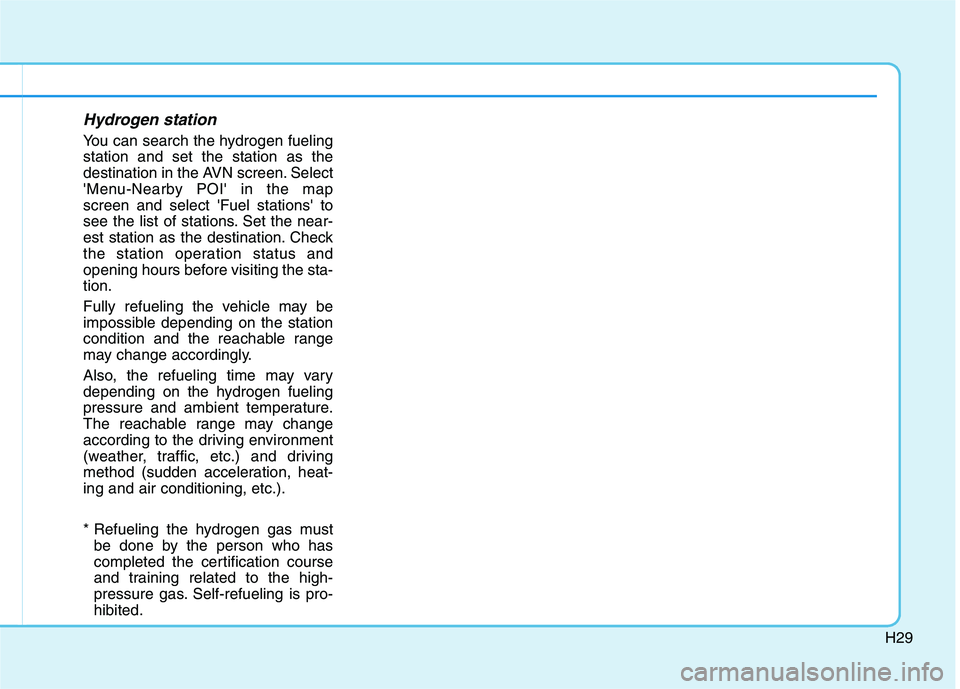
H29
Hydrogen station
You can search the hydrogen fueling station and set the station as the
destination in the AVN screen. Select
'Menu-Nearby POI' in the mapscreen and select 'Fuel stations' to
see the list of stations. Set the near-
est station as the destination. Check
the station operation status and
opening hours before visiting the sta-tion.
Fully refueling the vehicle may be
impossible depending on the station
condition and the reachable range
may change accordingly.
Also, the refueling time may vary
depending on the hydrogen fueling
pressure and ambient temperature.
The reachable range may change
according to the driving environment
(weather, traffic, etc.) and driving
method (sudden acceleration, heat-ing and air conditioning, etc.).
* Refueling the hydrogen gas mustbe done by the person who has
completed the certification course
and training related to the high-
pressure gas. Self-refueling is pro-hibited.
Page 532 of 558
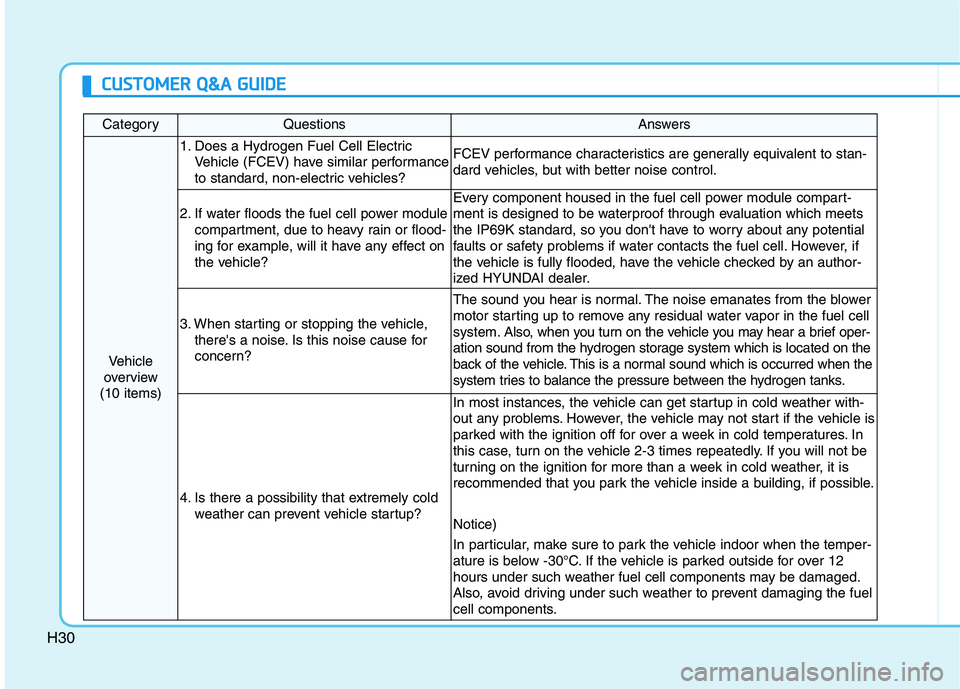
H30
CCUU SSTT OO MM EERR QQ && AA GG UU IIDD EE
CategoryQuestionsAnswers
Vehicle
overview
(10 items)
1. Does a Hydrogen Fuel Cell Electric Vehicle (FCEV) have similar performance
to standard, non-electric vehicles?FCEV performance characteristics are generally equivalent to stan-
dard vehicles, but with better noise control.
2. If water floods the fuel cell power modulecompartment, due to heavy rain or flood-
ing for example, will it have any effect on
the vehicle?
Every component housed in the fuel cell power module compart-
ment is designed to be waterproof through evaluation which meets
the IP69K standard, so you don't have to worry about any potential
faults or safety problems if water contacts the fuel cell. However, if
the vehicle is fully flooded, have the vehicle checked by an author-
ized HYUNDAI dealer.
3. When starting or stopping the vehicle,there's a noise. Is this noise cause for
concern?
The sound you hear is normal. The noise emanates from the blower
motor starting up to remove any residual water vapor in the fuel cellsystem. Also, when you turn on the vehicle you may hear a brief oper-
ation sound from the hydrogen storage system which is located on the
back of the vehicle. This is a normal sound which is occurred when the
system tries to balance the pressure between the hydrogen tanks.
4. Is there a possibility that extremely cold weather can prevent vehicle startup?
In most instances, the vehicle can get startup in cold weather with-
out any problems. However, the vehicle may not start if the vehicle is
parked with the ignition off for over a week in cold temperatures. In
this case, turn on the vehicle 2-3 times repeatedly. If you will not be
turning on the ignition for more than a week in cold weather, it is
recommended that you park the vehicle inside a building, if possible. Notice)
In particular, make sure to park the vehicle indoor when the temper-
ature is below -30°C. If the vehicle is parked outside for over 12
hours under such weather fuel cell components may be damaged.
Also, avoid driving under such weather to prevent damaging the fuel
cell components.
Page 533 of 558
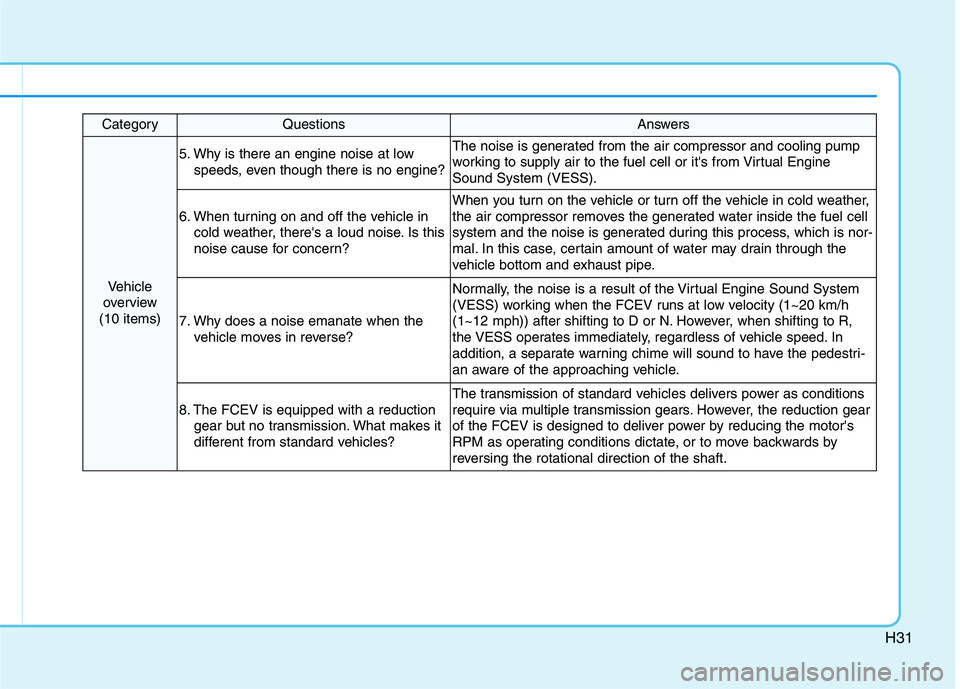
H31
CategoryQuestionsAnswers
Vehicle
overview
(10 items)
5. Why is there an engine noise at low speeds, even though there is no engine?The noise is generated from the air compressor and cooling pump
working to supply air to the fuel cell or it's from Virtual EngineSound System (VESS).
6. When turning on and off the vehicle incold weather, there's a loud noise. Is this
noise cause for concern?
When you turn on the vehicle or turn off the vehicle in cold weather,
the air compressor removes the generated water inside the fuel cell
system and the noise is generated during this process, which is nor-
mal. In this case, certain amount of water may drain through the
vehicle bottom and exhaust pipe.
7. Why does a noise emanate when thevehicle moves in reverse?
Normally, the noise is a result of the Virtual Engine Sound System
(VESS) working when the FCEV runs at low velocity (1~20 km/h
(1~12 mph)) after shifting to D or N. However, when shifting to R,
the VESS operates immediately, regardless of vehicle speed. In
addition, a separate warning chime will sound to have the pedestri-
an aware of the approaching vehicle.
8. The FCEV is equipped with a reduction
gear but no transmission. What makes it
different from standard vehicles?
The transmission of standard vehicles delivers power as conditions
require via multiple transmission gears. However, the reduction gear
of the FCEV is designed to deliver power by reducing the motor's
RPM as operating conditions dictate, or to move backwards by
reversing the rotational direction of the shaft.
Page 534 of 558
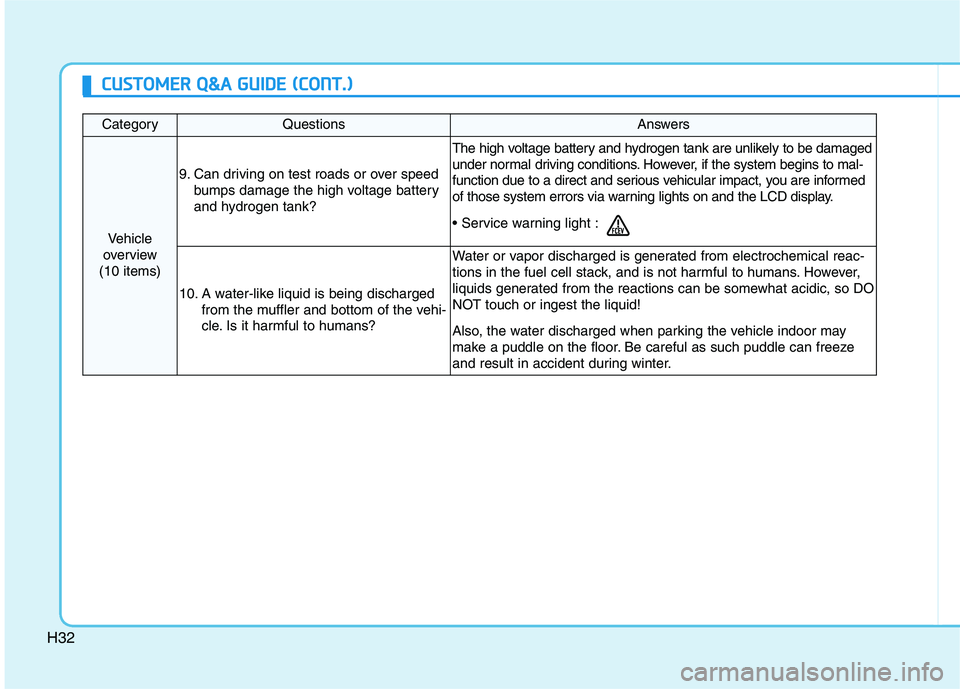
H32
CategoryQuestionsAnswers
Vehicle
overview
(10 items)
9. Can driving on test roads or over speed bumps damage the high voltage battery
and hydrogen tank?
The high voltage battery and hydrogen tank are unlikely to be damaged
under normal driving conditions. However, if the system begins to mal-
function due to a direct and serious vehicular impact, you are informed
of those system errors via warning lights on and the LCD display.
10. A water-like liquid is being discharged from the muffler and bottom of the vehi-
cle. Is it harmful to humans?
Water or vapor discharged is generated from electrochemical reac-
tions in the fuel cell stack, and is not harmful to humans. However,
liquids generated from the reactions can be somewhat acidic, so DO
NOT touch or ingest the liquid!
Also, the water discharged when parking the vehicle indoor may
make a puddle on the floor. Be careful as such puddle can freeze
and result in accident during winter.
CCUU SSTT OO MM EERR QQ &&AA GG UU IIDD EE (( CC OO NNTT..))
Page 535 of 558
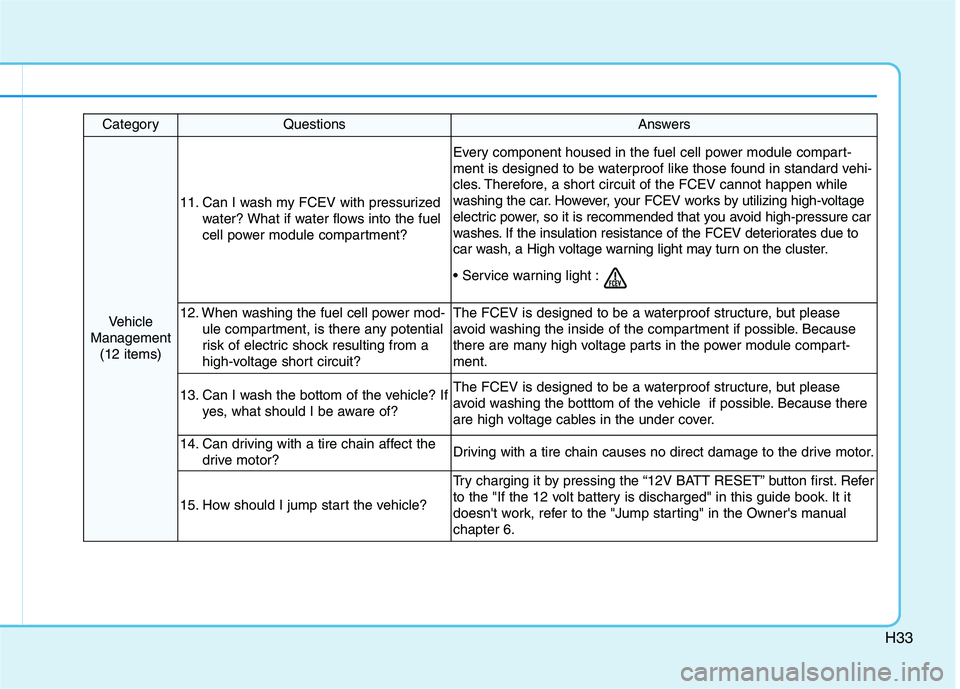
H33
CategoryQuestionsAnswers
Vehicle
Management (12 items)
11. Can I wash my FCEV with pressurized water? What if water flows into the fuel
cell power module compartment?
Every component housed in the fuel cell power module compart-
ment is designed to be waterproof like those found in standard vehi-
cles. Therefore, a short circuit of the FCEV cannot happen while
washing the car. However, your FCEV works by utilizing high-voltage
electric power, so it is recommended that you avoid high-pressure car
washes. If the insulation resistance of the FCEV deteriorates due to
car wash, a High voltage warning light may turn on the cluster.
12. When washing the fuel cell power mod-ule compartment, is there any potential
risk of electric shock resulting from a
high-voltage short circuit?The FCEV is designed to be a waterproof structure, but please
avoid washing the inside of the compartment if possible. Because
there are many high voltage parts in the power module compart-ment.
13. Can I wash the bottom of the vehicle? Ifyes, what should I be aware of?The FCEV is designed to be a waterproof structure, but please
avoid washing the botttom of the vehicle if possible. Because there
are high voltage cables in the under cover.
14. Can driving with a tire chain affect thedrive motor?Driving with a tire chain causes no direct damage to the drive motor.
15. How should I jump start the vehicle?
Try charging it by pressing the “12V BATT RESET” button first. Refer
to the "If the 12 volt battery is discharged" in this guide book. It it
doesn't work, refer to the "Jump starting" in the Owner's manualchapter 6.
Page 536 of 558
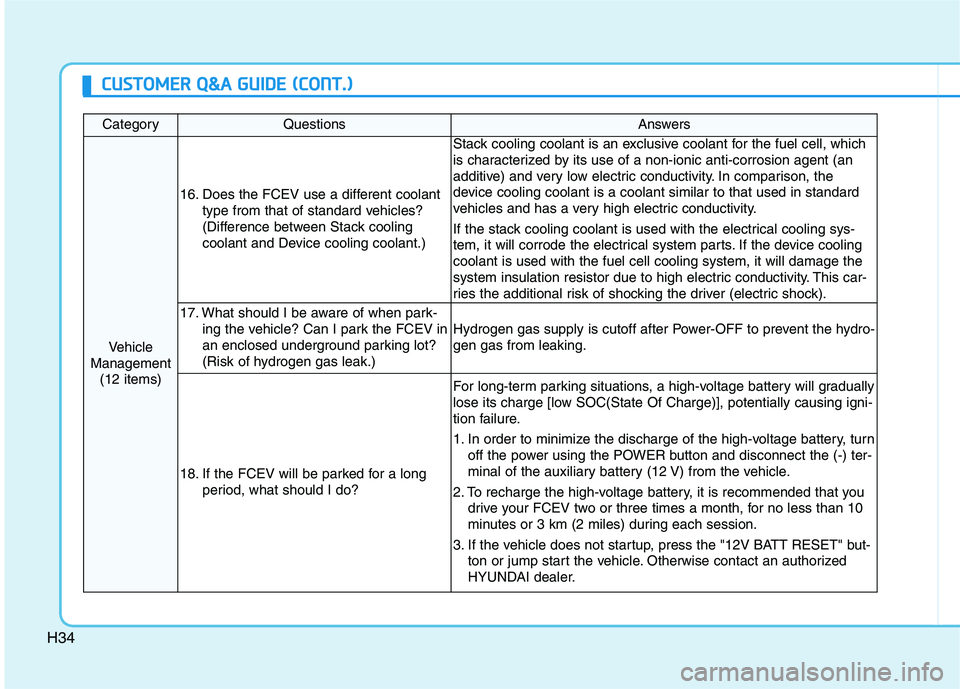
H34
CategoryQuestionsAnswers
Vehicle
Management (12 items)
16. Does the FCEV use a different coolant type from that of standard vehicles?
(Difference between Stack cooling
coolant and Device cooling coolant.)
Stack cooling coolant is an exclusive coolant for the fuel cell, which
is characterized by its use of a non-ionic anti-corrosion agent (an
additive) and very low electric conductivity. In comparison, the
device cooling coolant is a coolant similar to that used in standard
vehicles and has a very high electric conductivity.
If the stack cooling coolant is used with the electrical cooling sys-
tem, it will corrode the electrical system parts. If the device coolingcoolant is used with the fuel cell cooling system, it will damage the
system insulation resistor due to high electric conductivity. This car-
ries the additional risk of shocking the driver (electric shock).
17. What should I be aware of when park-ing the vehicle? Can I park the FCEV in
an enclosed underground parking lot?
(Risk of hydrogen gas leak.)
Hydrogen gas supply is cutoff after Power-OFF to prevent the hydro- gen gas from leaking.
18. If the FCEV will be parked for a longperiod, what should I do?
For long-term parking situations, a high-voltage battery will gradually
lose its charge [low SOC(State Of Charge)], potentially causing igni-
tion failure.
1. In order to minimize the discharge of the high-voltage battery, turnoff the power using the POWER button and disconnect the (-) ter-
minal of the auxiliary battery (12 V) from the vehicle.
2. To recharge the high-voltage battery, it is recommended that you drive your FCEV two or three times a month, for no less than 10
minutes or 3 km (2 miles) during each session.
3. If the vehicle does not startup, press the "12V BATT RESET" but- ton or jump start the vehicle. Otherwise contact an authorized
HYUNDAI dealer.
CCUU SSTT OO MM EERR QQ &&AA GG UU IIDD EE (( CC OO NNTT..))
Page 537 of 558

H35
CategoryQuestionsAnswers
Vehicle
Management (12 items)
19. What are the do-it-yourself (DIY) main-
tenance items for the FCEV?
DIY Check: Device cooling coolant, Stack cooling coolant, Brake
Fluid, Tire and Wheels
DIY Maintenance: Washer fluid, Air cleaner, Climate control air filter,
Wiper blades, Fuse, Light bulb
20. What should I be aware of when doingDIY maintenance work?Be careful not to touch the high-voltage cable (orange color),
coolant, and ion filter.
21. Tell me what the potential effects are ofparking long-term in a cold area (-20 °C
(-4 °F)) for the FCEV, and whether or
not the vehicle can startup under such
conditions.In most instances, the vehicle can get startup in cold weather with-
out any problems. However, the vehicle may not start if it is parked
with the power off for over a week in cold temperatures. In this case,
If you will not be turning on the vehicle for more than a week in cold
weather, it is recommended that you park the vehicle inside a build-
ing, if possible.
22. What parts must I not touch with
hands? For example, high-voltage
cable, ion filter, etc.?
High-voltage cable (orange color), ion filter, parts with a high voltage
warning sticker.
Also, never touch the hydrogen storage system under the tailgate,
the hydrogen supply pipe under the vehicle and the hydrogen supply
system components on the right side (based on the driver’s position)of the hood.
Page 538 of 558
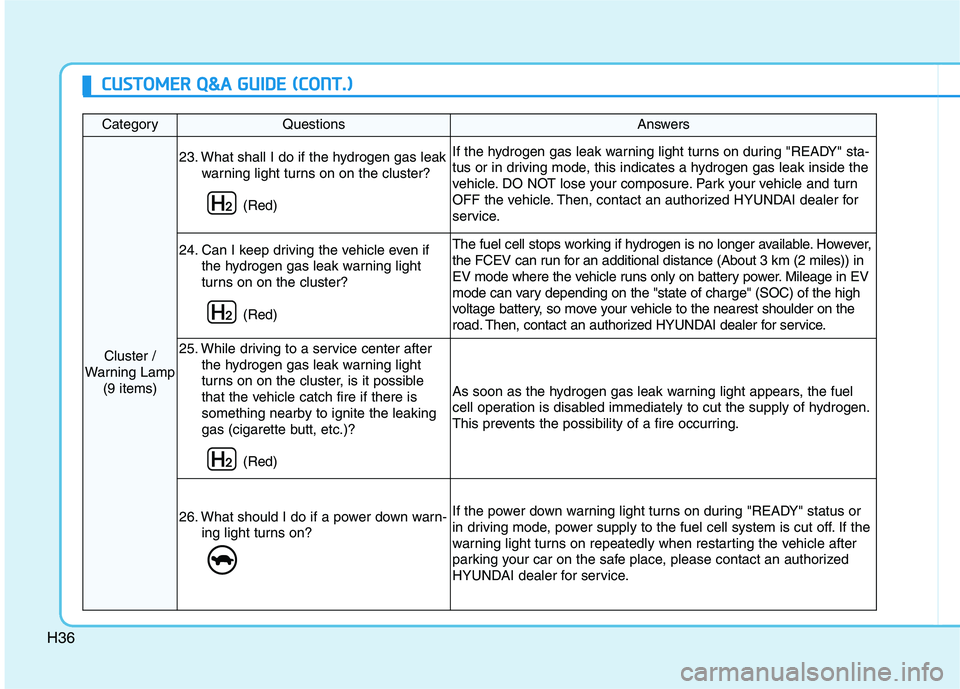
H36
CategoryQuestionsAnswers
Cluster /
Warning Lamp
(9 items)
23. What shall I do if the hydrogen gas leak warning light turns on on the cluster?
(Red)If the hydrogen gas leak warning light turns on during "READY" sta-
tus or in driving mode, this indicates a hydrogen gas leak inside the
vehicle. DO NOT lose your composure. Park your vehicle and turn
OFF the vehicle. Then, contact an authorized HYUNDAI dealer for
service.
24. Can I keep driving the vehicle even ifthe hydrogen gas leak warning light
turns on on the cluster?
(Red)The fuel cell stops working if hydrogen is no longer available. However,
the FCEV can run for an additional distance (About 3 km (2 miles)) in
EV mode where the vehicle runs only on battery power. Mileage in EV
mode can vary depending on the "state of charge" (SOC) of the high
voltage battery, so move your vehicle to the nearest shoulder on the
road. Then, contact an authorized HYUNDAI dealer for service.
25. While driving to a service center afterthe hydrogen gas leak warning light
turns on on the cluster, is it possible
that the vehicle catch fire if there is
something nearby to ignite the leaking
gas (cigarette butt, etc.)?
(Red)
As soon as the hydrogen gas leak warning light appears, the fuel
cell operation is disabled immediately to cut the supply of hydrogen.
This prevents the possibility of a fire occurring.
26. What should I do if a power down warn-ing light turns on?If the power down warning light turns on during "READY" status or
in driving mode, power supply to the fuel cell system is cut off. If the
warning light turns on repeatedly when restarting the vehicle after
parking your car on the safe place, please contact an authorized
HYUNDAI dealer for service.
CCUU SSTT OO MM EERR QQ &&AA GG UU IIDD EE (( CC OO NNTT..))
Page 539 of 558
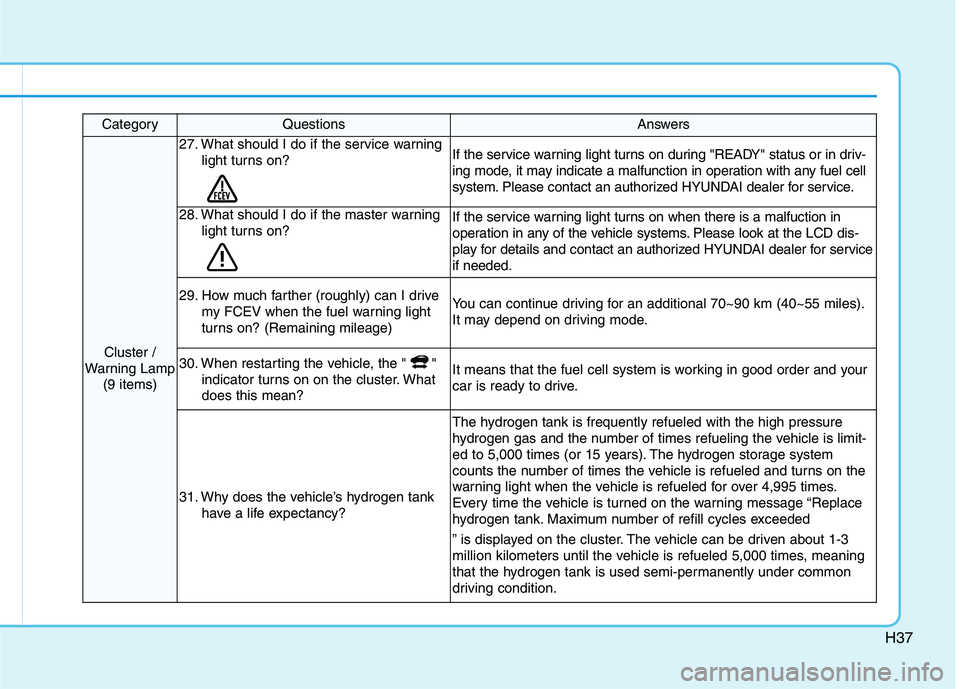
H37
CategoryQuestionsAnswers
Cluster /
Warning Lamp (9 items)
27. What should I do if the service warning
light turns on?If the service warning light turns on during "READY" status or in driv-
ing mode, it may indicate a malfunction in operation with any fuel cell
system. Please contact an authorized HYUNDAI dealer for service.
28. What should I do if the master warninglight turns on?If the service warning light turns on when there is a malfuction in
operation in any of the vehicle systems. Please look at the LCD dis-
play for details and contact an authorized HYUNDAI dealer for serviceif needed.
29. How much farther (roughly) can I drivemy FCEV when the fuel warning light
turns on? (Remaining mileage)You can continue driving for an additional 70~90 km (40~55 miles).
It may depend on driving mode.
30. When restarting the vehicle, the " "indicator turns on on the cluster. What does this mean?It means that the fuel cell system is working in good order and your
car is ready to drive.
31. Why does the vehicle’s hydrogen tankhave a life expectancy?
The hydrogen tank is frequently refueled with the high pressure
hydrogen gas and the number of times refueling the vehicle is limit-
ed to 5,000 times (or 15 years). The hydrogen storage system
counts the number of times the vehicle is refueled and turns on the
warning light when the vehicle is refueled for over 4,995 times.
Every time the vehicle is turned on the warning message “Replace
hydrogen tank. Maximum number of refill cycles exceeded
” is displayed on the cluster. The vehicle can be driven about 1-3
million kilometers until the vehicle is refueled 5,000 times, meaning
that the hydrogen tank is used semi-permanently under common
driving condition.
Page 540 of 558
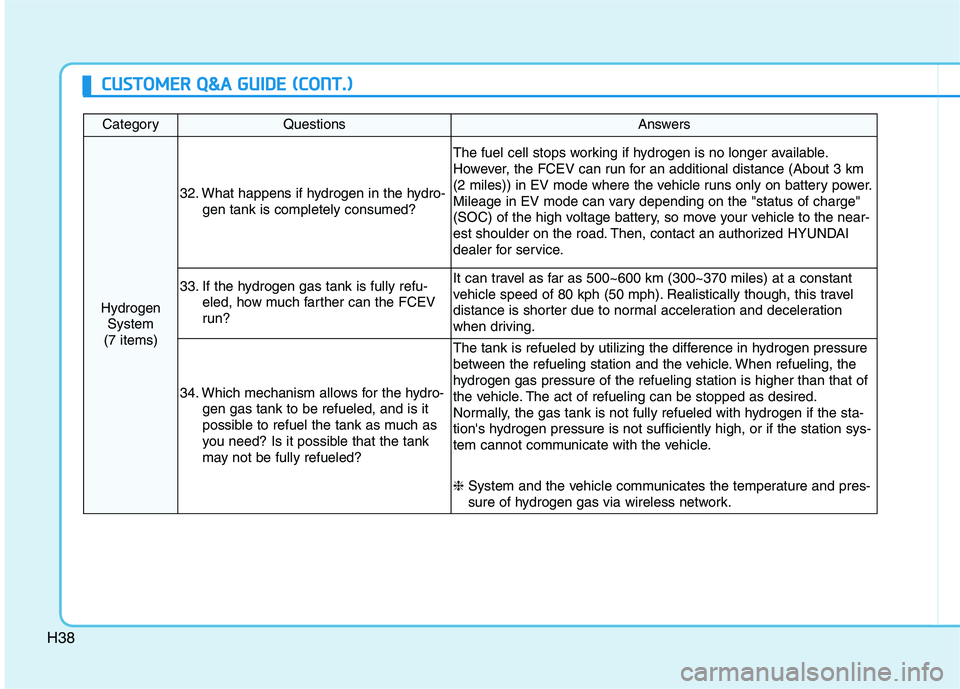
H38
CategoryQuestionsAnswers
HydrogenSystem
(7 items)
32. What happens if hydrogen in the hydro- gen tank is completely consumed?
The fuel cell stops working if hydrogen is no longer available.
However, the FCEV can run for an additional distance (About 3 km
(2 miles)) in EV mode where the vehicle runs only on battery power.
Mileage in EV mode can vary depending on the "status of charge"
(SOC) of the high voltage battery, so move your vehicle to the near-
est shoulder on the road. Then, contact an authorized HYUNDAI
dealer for service.
33. If the hydrogen gas tank is fully refu-eled, how much farther can the FCEV
run?It can travel as far as 500~600 km (300~370 miles) at a constant
vehicle speed of 80 kph (50 mph). Realistically though, this travel
distance is shorter due to normal acceleration and deceleration
when driving.
34. Which mechanism allows for the hydro-
gen gas tank to be refueled, and is it
possible to refuel the tank as much as
you need? Is it possible that the tank
may not be fully refueled?
The tank is refueled by utilizing the difference in hydrogen pressure
between the refueling station and the vehicle. When refueling, the
hydrogen gas pressure of the refueling station is higher than that of
the vehicle. The act of refueling can be stopped as desired.
Normally, the gas tank is not fully refueled with hydrogen if the sta-
tion's hydrogen pressure is not sufficiently high, or if the station sys-
tem cannot communicate with the vehicle. ❈System and the vehicle communicates the temperature and pres-
sure of hydrogen gas via wireless network.
CCUU SSTT OO MM EERR QQ &&AA GG UU IIDD EE (( CC OO NNTT..))